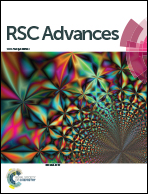Behaviour of zinc during the process of leaching copper from WPCBs by typical acidic ionic liquids†
Abstract
Waste printed circuit boards (WPCBs) have attracted more and more attention, which is mainly focused on the recovery of valuable metals, especially copper. Few studies have been reported on the behaviour of heavy metals during the process of recycling copper from WPCBs. Hence, we selected zinc to represent the heavy metals and examined its behaviour in a typical acidic ionic liquid (IL) leaching system. The factors that affect the zinc leaching rate, such as particle size, temperature, ionic liquid concentration, volume of H2O2 added and solid to liquid ratio, were examined in detail. The result showed that zinc could be leached out successfully in five typical acidic ILs and the zinc leaching rate was significantly impacted by the volume of H2O2 added, solid to liquid ratio and temperature. In addition, the zinc leaching rate by [BSO3HMIm]OTf was almost the same as [BSO3HPy]OTf. Moreover, the acidic IL with CF3SO3− was less efficient than the acidic IL with HSO4−. Although zinc could restrain the leaching of copper because of the substitution reaction between metallic zinc and Cu2+, the two show almost the same tendency. The results of the zinc leaching kinetics analysis indicated that diffusion played a more important role than the surface reaction, which was the same as copper, but different from inorganic acids, which are usually controlled by the surface reaction.


 Please wait while we load your content...
Please wait while we load your content...